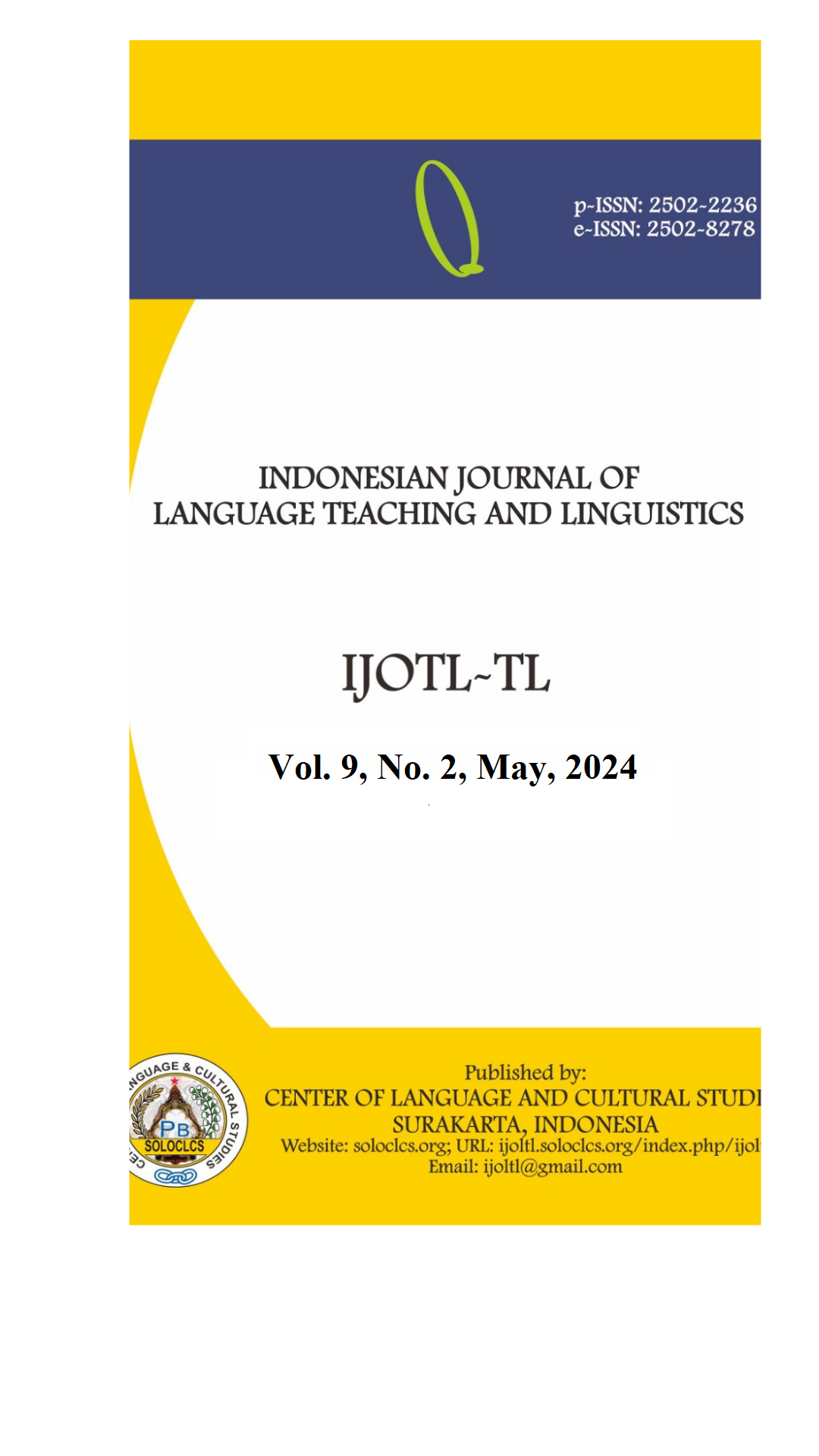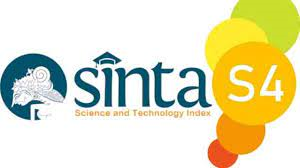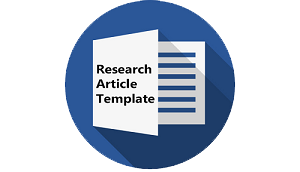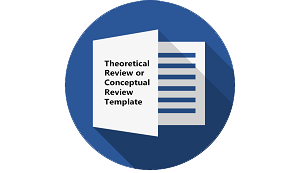The assessment of reading speed at the word level in German for bilingual Arabic-German students in Germany
DOI:
https://doi.org/10.30957/ijoltl.v9i2.809Keywords:
Arabic, Bilingual Pupils, Germany, Reading SpeedAbstract
Research indicates that the German reading abilities of children with migration backgrounds are generally inferior when compared to their monolingual German counterparts. Previous studies have primarily concentrated on Turkish-German bilingual children, with limited attention given to those who speak other first languages. Notably, the reading skills of bilingual Arabic-German children have yet to be thoroughly explored. This study aims to assess the German reading speed at the word level among bilingual Arabic-German students in Germany. A one-minute reading test was administered to a sample of 66 bilingual Arabic-German children, with a mean age of 9;02 years. One group of 33 children received instruction in both German and Arabic, while the other group of 33 received only German instruction in school, with Arabic being taught outside of school. The results indicated no significant differences between the groups regarding the German tasks, and neither group exhibited signs of difficulties in German literacy.
Downloads
References
AlJassmi, M. A., Warrington, K. L., McGowan, V. A., White, S. J., & Paterson, K. B. (2022). Effects of word predictability on eye movements during Arabic reading. Attention, Perception, & Psychophysics, 1-15
Anderson, N. J. (2015). Academic reading expectations and challenges. In N. Evans, N. Anderson, & W. Eggington (Eds.), ESL readers and writers in higher education (pp. 95– 109). Routledge
Araújo, S., Reis, A., Petersson, K. M., & Faísca, L. (2015). Rapid automatized naming and reading performance: A meta-analysis. Journal of Educational Psychology, 107(3), 868–883.
Artelt, Cordula u. a. (2001): PISA 2000: Lesekompetenz: Testkonzeption und Ergebnisse. In: Deutsches PISA-Konsortium (Hrsg.): PISA 2000. Basiskompetenzen von Schülerinnen und Schülern im internationalen Vergleich. Opladen, 69–140.
Auer, M., Gruber, G., Mayringer, H., & Wimmer, H. (2005). SLS 5–8. Salzburger Lese-Screening für die Klassenstufen 5–8 [Salzburger reading screening for grade levels 5–8]. Bern: Huber.
Asrifan, A., Amri, N. A., Hajerah, H., Rusmayadi, R., & Musi, M. A. (2025). Second Acts in Education: The Impact of Retired Educators on Literacy Programs and Student Outcomes. In Former Educators' Roles in Supporting Student Growth and Learning (pp. 175-204). IGI Global Scientific Publishing.
Beauftragte der Bundesregierung fuer Migration, Fluechtlinge und Integration (2014, October). 10. Bericht ueber die Lage der Auslaenderinnen und Auslaender in Deutschland [Federal Government Commissioner for Migration, Refugees and Integration. 10th report on the situation of foreigners in Germany]
Becker-Mrotzek, M., Hentschel, B., Hippmann, K., & Linnemann, M. (2012, June). Sprachfoerderung in deutschen Schulen – die Sicht der Lehrerinnen und Lehrer. Ergebnisse einer Umfrage unter Lehrerinnen und Lehrern [Language support in German schools - the teachers' view. Results of a survey among teachers]. https://www.mercator-institutsprachfoerderung.de/fileadmin/user_upload/Lehrerumfrage_Langfassung_final_30_0 5_03.pdf
Banfi C.; Keme´ny F.; Gangl M.; Schulte-Körne G.; Moll K.; Landerl K. (2018) Visual attention span performance in German-speaking children with differential reading and spelling profiles: No evidence of group differences. PLoS ONE 13(6), 1-17.
Bar-Kochva, I., Vágvoelgyi, R., Dresler, T., Nagengast, B., Schroeter, H., Schrader, J., & Nuerk, H.-C. (2021). Basic reading and reading-related language skills in adults with deficient reading comprehension who read a transparent orthography. Reading and Writing.
Brasseur-Hock, I. F., Hock, M. F., Kieffer, M. J., Biancarosa, G., & Deshler, D. D. (2011). Adolescent struggling readers in urban schools: Results of a latent class analysis. Learning and Individual Differences, 21(4), 438–452
Borodkin, K., & Faust, M. (2014). Naming abilities in low-proficiency second language learners. Journal of Learning Disabilities, 47(3), 237–253.
Bos, W. et al. (Hrsg.) (2007): IGLU 2006. Lesekompetenzen von Grundschulkindern in Deutschland im internationalen Vergleich. Münster: Waxmann.
Caspar U.; Leyendecker B. (2011). Deutsch als Zweitsprache. Z. Entwickl. Padagogis. 43 118-132.
Chall, J. S., & Jacobs, V. A. (2003). The classic study on poor children’s fourth-grade slump.
American Educator, 27(1), 14–15, 44.
Chatterji, M. (2006). Reading achievement gaps, correlates, and moderators of early reading achievement: Evidence from the Early Childhood Longitudinal Study (ECLS) kindergarten to first grade sample. Journal of educational psychology, 98(3), 489.
Chen, Y.-J. I., Thompson, C. G., Xu, Z., Irey, R. C., & Georgiou, G. K. (2021). Rapid
automatized naming and spelling performance in alphabetic languages: A metaanalysis. Reading and Writing.
Cirino, P. T., Romain, M. A., Barth, A. E., Tolar, T. D., Fletcher, J. M., & Vaughn, S. (2013).
Reading skill components and impairments in middle school struggling readers.
Reading and Writing, 26(7), 1059–1086.
Cohen, M., Mahé, G., Laganaro, M., & Zesiger, P. (2018). Does the relation between rapid
automatized naming and reading depend on age or on reading level? A behavioral and
ERP study. Frontiers in Human Neuroscience, 12, 73.
Conrad, N. J., & Levy, B. A. (2007). Letter processing and the formation of memory
representations in children with naming speed deficits. Reading and Writing: An
Interdisciplinary Journal, 20(3), 201–223
Cree, A., Kay, A., & Steward, J. (2012). The economic and social cost of illiteracy: A snapshot of illiteracy in a global context. Final report from the World Literacy Foundation.
http://hdl.voced.edu.au/10707/321997
Dixon, L. Q., Zhao, J., Shin, J. Y., Wu, S., Su, J. H., Burgess-Brigham, R., ... & Snow, C. (2012). What we know about second language acquisition: A synthesis from four perspectives. Review of educational research, 82(1), 5-60.
Duzy, D., Souvignier, E., Ehm, J. H., & Gold, A. (2014). Early decoding speed and later reading competencies in children with German as a second language. Child Indicators Research, 7, 787-804.
Eme, E., Lambert, E., & Alamargot, D. (2014). Word reading and word spelling in French adult literacy students: The relationship with oral language skills. Journal of Research in Reading, 37(3), 268–296.
Escarpio, R., & Barbetta, P. (2016). Comparison of repeated and non-repeated readings on the reading performances of students with emotional and behavioral disorders. Journal of Emotional and Behavioral Disorders, 24(2), 111–124.
Gangl, M., Moll, K., Jones, M. W., Banfi, C., Schulte-Koerne, G., & Landerl, K. (2018). Lexical reading in dysfluent readers of German. Scientific Studies of Reading, 22(1), 24–40.
Grabe, W. (2009). Reading in a second language: Moving from theory to practice. Cambridge University Press.
Grabe, W. (2010). Fluency in reading: Thirty-five years later. Reading in a Foreign Language, 22(1), 71–83.
Grabe, W., & Stoller, F. L. (2011). Teaching and researching reading (2nd ed.). Pearson Education.
Harju-Luukkainen, H., McElvany, N., & Stang, J. (2020). Monitoring student achievement in the 21st century. European policy perspectives and assessment strategies. Springer Nature Switzerland AG.
Huschka, S. S., Georgiou, G. K., Brandenburg, J., Ehm, J.-H., & Hasselhorn, M. (2021). Examining the contribution of RAN components to reading fluency, reading comprehension, and spelling in German. Reading and Writing.
Feld-Knapp, I. (2014). Universitäre DaF-Lehrerausbildung in Ungarn im Spannungsfeld von Traditionen und neuen Herausforderungen. München: Iudicium.
Frith, U.; Wimmer, H.; Landerl, K. (1998). Differences in phonological recoding in German-and English-speaking children. Scientific Studies of Reading, 2(1), 31-54.
Jeon, E. (2009). Effects of repeated reading on L2 reading fluency and comprehension. (Unpublished doctoral dissertation). Northern Arizona University
Joshi, R. M., & McCardle, P. (2018). Models of reading in different orthographies: An introduction. Journal of Learning Disabilities, 51(5), 419–421.
Jeuk, S. (2018). Deutsch als Zweitsprache in der Schule. Grundlagen, Diagnose, Foerderung [German as a second language in school. Basics, diagnosis, support] (4th ed.). Kohlhammer.
Kato, M. (2018). Exploring the transfer relationship of summarizing skills in L1 and L2. English Language Teaching, 11(10), 75−87.
Kliegl, R., Grabner, E., Rolfs, M., & Engbert, R. (2004). Length, frequency, and predictability effects of words on eye movements in reading. European Journal of Cognitive Psychology, 16(1-2), 262-284.
Klicpera, Ch.; Schabmann, A.; Gasteiger-Klicpera, B. (2010). Legasthenie–LRS–Modelle, Diagnose, Therapie und Förderung. Reinhardt, München.
Klieme, E. et al. (Hrsg.) (2010): PISA 2009. Bilanz nach einem Jahrzehnt. Münster: Waxmann.
Knoepke, J., Richter, T., Isberner, M. B., Naumann, J., and Neeb, Y. (2014). Phonological recoding, orthographic decoding, and comprehension skills during reading acquisition. Z. Erzieh. 17, 447–471.
Landerl, K., & Wimmer, H. (2000). Deficits in phoneme segmentation are not the core problem of dyslexia: Evidence from German and English children. Applied Psycholinguistics, 21(2), 243–262.
Landerl, K., & Wimmer, H. (2008). Development of word reading fluency and spelling in a consistent orthography: An 8-year follow-up. Journal of Educational Psychology, 100(1), 150–161.
Landerl, K., Freudenthaler, H. H., Heene, M., de Jong, P. F., Desrochers, A., Manolitsis, G., Parrila, R., & Georgiou, G. K. (2019). Phonological awareness and rapid automatized naming as longitudinal predictors of reading in five alphabetic orthographies with varying degrees of consistency. Scientific Studies of Reading, 23(3), 220–234.
Lee, J. A. C., Lee, S., Yusoff, N. F. M., Ong, P. H., Nordin, Z. S., & Winskel, H. (2020). An early reading assessment battery for multilingual learners in Malaysia. Frontiers in Psychology, 11, 1700.
Little, C. W., Hart, S. A., Quinn, J. M., Tucker-Drob, E. M., Taylor, J., & Schatschneider, C. (2017). Exploring the co-development of reading fluency and reading comprehension: a twin study. Child Development, 88(3), 934–945.
Livingston, E. M., Siegel, L. S., & Ribary, U. (2018). Developmental dyslexia: Emotional impact and consequences. Australian Journal of Learning Difficulties, 23(2), 107–135.
Macdonald, S. J., Deacon, L., & Merchant, J. (2016). “Too far gone”: Dyslexia, homelessness, and pathways to drug use and dependency. Insights into Learning Disabilities, 13(2), 117–134.
Martin, M. O., Mullis, I. V., & Kennedy, A. M. (2007). Progress in International Reading Literacy Study (PIRLS): PIRLS 2006 Technical Report. International Association for the Evaluation of Educational Achievement.
Melby-Lervåg, M., & Lervåg, A. (2011). Cross-linguistic transfer of oral language, decoding, phonological awareness and reading comprehension: A meta-analysis of the correlational evidence. Journal of Research in Reading, 34(1), 114–135.
Melby-Lervåg, M. & Lervåg, A. (2014). Reading comprehension and its underlying components in second-language learners: A meta-analysis of studies comparing first-and secondlanguage learners. Psychological Bulletin, 140(2), 409–433.
Mayer, A. (2018). Benennungsgeschwindigkeit und Lesen. Rapid automatized Naming (RAN) and Reading. Forschung Sprache, 6(1), 20-41.
Moll, K., & Landerl, K. (2010). SLRT-II: Reading- Spelling-Test; New Version of the Salzburger Lese-und Rechtschreibtests (SLRT). Huber.
Molnár, T. (2008). Second language versus third language vocabulary acquisition: A comparison of the English lexical competence of monolingual and bilingual students. Toronto Working Papers in Linguistics (TWPL), 33, 1–16.
Muthén, L.K. & Muthén, B.O. (1998-2015). Mplus User’s Guide. Seventh Edition. Los Angeles, CA: Muthén & Muthén.
Muthén, B.O. & Asparouhov, T. (2002). Latent variable analysis with categorical outcomes: Multiple-group and growth modeling in Mplus. Mplus Web Notes No. 4, Version 5, December 9.
Naddaf, E. (2016). The measurement of reading fluency (word level) in Arabic for Arabic monolingual and bilingual Arabic-German pupils in Germany. Qiyas Maharah Al-Qira'ah 'ala Mustawa al-Kalimah bi al-Lughah al-'Arabiyah Lada al-Talamidz Ahadiya Wa Tsana'iy al-Lughah fi Almaniya. Arabiyat: Jurnal Pendidikan Bahasa Arab dan Kebahasaaraban, 3(2), 246-266.
OECD (2015) retrieved from Gurria, A. (2016). PISA 2015 results in focus. PISA in Focus, (67), 1.
Organisation for Economic Co-operation and Development (OECD). (2010). PISA 2009 results: What students know and can do student performance in reading, mathematics and science. OECD Publishing.
Oxford, R. L. (2017). Conditions for second language (L2) learning. In N. Van Deusen-Scholl & S. May (Eds.), Second and foreign language education, encyclopedia of language and education (pp. 27–41). Springer.
Paige, D. D., Magpuri-Lavell, T., Rasinski, T. V., & Smith, G. (2013). Interpreting the relationships among prosody, automaticity, accuracy, and silent reading comprehension in secondary students. Journal of Literacy Research, 46(2), 123–156.
Park, Y., Chaparro, E. A., Preciado, J., & Cummings, K. D. (2015). Is earlier better? Mastery of reading fluency in early schooling. Early Education and Development, 26(8), 1187-1209.
Papadopoulos, T. C., Spanoudis, G. C., & Georgiou, G. K. (2016). How is RAN related to reading fluency? A comprehensive examination of the prominent theoretical accounts. Frontiers in Psychology, 7, 1–15.
Rasinski, T., & Young, C. (2017). Effective instruction for primary grade students who struggle with reading fluency. In M. Milton (Ed.), Inclusive Principles and Practices in Literacy Education (vol. 11, pp. 143‒157). Emerald Publishing Limited.
Sass, D.A., Schmitt T.A. & Marsh, H.W. (2014). Evaluating model fit with ordered categorical data within a measurement invariance framework: A comparison of estimators. Structural Equation Modeling, 21(2), 167-180.
Schabmann, A.; Schmidt, B. M.,; Klicpera, C.; Gasteiger-Klicpera, B.; Klingebiel, K. (2009). Does systematic reading instruction impede prediction of reading a shallow orthography? Psychology Science Quarterly, 51(3), 315-338.
Schmitt, N. (2008). Review article: Instructed second language vocabulary learning. Language Teaching Research, 12(3), 329–363.
Schleicher, A. (2019). PISA 2018. Insights and interpretations. OECD. https://www.oecd.org/pisa/PISA%202018%20Insights%20and%20Interpretations%20 FINAL%20PDF.pdf
Schwab, S., Seifert, S., & Gasteiger-Klicpera, B. (2013). Reading intervention in second-grade children with poor reading abilities. Procedia—Social and Behavioral Sciences, 106, 2205–2216.
Stæhr, L. S. (2009). Vocabulary knowledge and advanced listening comprehension in English as a foreign language. Studies in Second Language Acquisition, 31(4), 577‒607
Stanley, C. T., Petscher, Y., & Catts, H. (2018). A longitudinal investigation of direct and indirect links between reading skills in kindergarten and reading comprehension in tenth grade. Reading and Writing, 31(1), 133–153.
Steinle, P. K., Stevens, E., & Vaughn, S. (2021). Fluency interventions for struggling readers in grades 6 to 12: A research synthesis. Journal of Learning Disabilities.
Stevens, E. A., Walker, M. A., & Vaughn, S. (2017). The effects of reading fluency interventions on the reading fluency and reading comprehension performance of elementary students with learning disabilities: A synthesis of the research from 2001 to 2014. Journal of Learning Disabilities, 50(5), 576‒590.
Stevens Taha, H., & Taha, H. (2019). Morpho-orthographic preferences among typical and poor native Arab readers. Writing Systems Research, 11(2), 212-225.
Taha-Thomure, H. (2023). What brain imaging research and science of reading can do for Arabic language teaching & learning. New science of learning: Exploration in mind, brain, and education, 20-39.
Thomure, H. T., Brown, G., Speaker, R., Taha, H., Tamim, R., & O’Neill, N. (2022). Arabic Reading Fluency Rates: An Exploratory Study. Gulf Education and Social Policy Review (GESPR), 1-24.
Toste, J. R., Capin, P., Williams, K. J., Cho, E., &Vaughn, S. (2019). Replication of an experimental study investigating the efficacy of a multisyllabic word reading intervention with and without motivational beliefs training for struggling readers. Journal of Learning Disabilities, 52(1), 45‒58.
van Gorp, K., Segers, E., & Verhoeven, L. (2017). The role of feedback and differences between good and poor decoders in a repeated word reading paradigm in first grade. Annals of Dyslexia, 67, 1 – 25
Wendt, H., Smith, D. S., & Bos, W. (2016). Germany. In I. V. S. Mullis, M. O. Martin, S. Goh, & K. Cotter (Eds.), TIMSS 2015 encyclopedia: Education policy and curriculum in mathematics and science. http://timssandpirls.bc.edu/timss2015/encyclopedia/
Wimmer, H.; Hummer, P. (1990). How German-speaking first graders read and spell: Doubts on the importance of the logographic stage. Applied Psycholinguistics, 11(04), 349-368.
Wu, S., Stratton, K. K., & Gadke, D. L. (2020). Maximizing repeated readings: The effects of a multicomponent reading fluency intervention for children with reading difficulties. Contemporary School Psychology, 24(2), 217–227.
Younes, M. (2015). The Integrated Approach to Arabic Instruction. Routledge taylor & francis group.
Young, D., Schaefer, M. Y., & Lesley, J. (2019). Accommodating students with disabilities studying English as a foreign language. Journal of Postsecondary Education and Disability, 32(3), 311–319.
Zarić, J., & Nagler, T. (2021). Reading comprehension on word- and sentence-level can be predicted by orthographic knowledge for German children with poor reading proficiency. Reading and Writing.
Downloads
Published
How to Cite
Issue
Section
License
Copyright (c) 2025 Naddaf Esra

This work is licensed under a Creative Commons Attribution-ShareAlike 4.0 International License.
Authors who publish with this journal agree to the following terms:
- Authors retain copyright and grant the journal right of first publication with the work simultaneously licensed under a Creative Commons Attribution-ShareAlike 4.0 International License that allows others to share the work with an acknowledgement of the work's authorship and initial publication in this journal.
- Authors are able to enter into separate, additional contractual arrangements for the non-exclusive distribution of the journal's published version of the work (e.g., post it to an institutional repository or publish it in a book), with an acknowledgement of its initial publication in this journal.
- Authors are permitted and encouraged to post their work online (e.g., in institutional repositories or on their website) prior to and during the submission process, as it can lead to productive exchanges, as well as earlier and greater citation of published work (See The Effect of Open Access).












